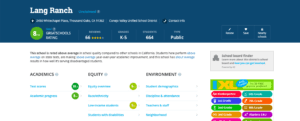You may have noticed that some of Conejo Valley’s favorite schools have dropped a point or two on their GreatSchools rating. Schools like Lang Ranch Elementary and Westlake High School have seen some fluctuation in their overall scoring.
We have good news…
It’s not at all what it seems – they just changed the way they do their ratings.
For a long time, a school’s score focused solely on academics. Specifically, test scores and academic progress.
Now, GreatSchools takes a number of things into account – test scores, academic progress, equity & achievement gaps, and fairness for low-income students. It looks like this:

GreatSchools | 2/14/20
Great Schools in the Conejo Valley
We’ve also noticed the shift in local ratings and have since done some research.
It’s not the academic ratings that’s affecting a school’s score. Chances are, their academic ratings haven’t changed. From what we can tell, it’s the newer categories that are causing the shift in some of the scores.
No matter the school, ratings are set based on how it compares to its home state. For instance, Lang Ranch students test higher than the average California student. Therefore, the school receives a high score in that category. When comparing test scores of an entire student body to an entire state, there’s no real need to account for other variables.
Equity Rating
GreatSchools’ equity rating measures how well a school serves the academic development of all its students, including different socioeconomic backgrounds. Of course, this is a great thing. The idea is to hold schools accountable and to make sure that all students are being treated fairly and offered the same education.
GreatSchools low-income rating is measured by comparing test scores for students who qualify for free or reduced-price lunch to all students in the state.
The truth is, some of our schools are scoring better than others in their Equity Rating. But, it’s hard to say for sure whether there might be other variables playing a role here.
A Quick Note: GreatSchools is an incredibly reputable source. This is not at all intended to de-bunk their facts and findings. GreatSchools is constantly weighing factors and measurements according to incoming data. This example is simply meant to represent a possible reason why some data may not properly represent a schools score.
For Example
Let’s say School A has an average household income of $150,000, while School B has an average of $70,000. We could guess that School B is likely to have more students considered “low-income” compared to School A.
Now let’s say both schools have a total of 100 students. School B has 20 low-income students, while School A has 10 low-income students.
To calculate GreatSchools equity score, we’d take School A’s 10 kids and School B’s 20 kids, and compare each group to state averages. You can start to see where it’s not as black and white as it was when comparing test score averages – we’re adding new ratios to the mix.
If 3 students from each school were falling behind, that would be 30% of low income students for School A (3 out of 10), but only 15% of low income students for School B (3 out of 20).
In this case, School A would score much lower than School B in their equity rating. But, is it lack of attention to low-income students or is it lack of low-income students?
Truthfully, it’s hard to say anything for sure
GreatSchools’ new approach to ratings is just that…new. So, it really is hard to say anything with 100% certainty. It seems reasonable to us that taking each school on a case by case basis is wise. And our two pieces of advice are as follows:
- Double check each schools’ academic scores
- Don’t be afraid to reach out to any given school and ask questions
Your student should be treated equally. So, if you find your desired school isn’t hitting the mark in its equity rating, call and ask some questions. As you navigate a GreatSchools profile, they’ll give you some advice on what questions to ask and how to advocate for your student (if necessary).





